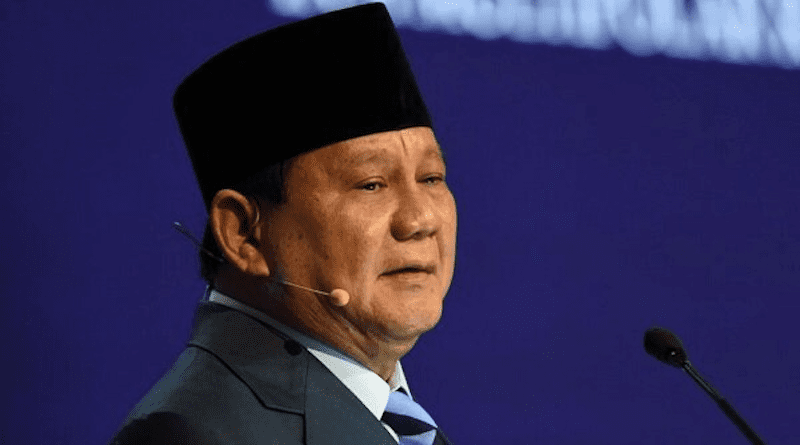Indonesia: Prabowo Bites Off More Than He Can Chew With Free Lunch Promise – Analysis
By Muhammad Rafi Bakri
The landslide victory of Defence Minister Prabowo Subianto in Indonesia’s 14 February 2024 presidential election has been been confirmed, with Subianto officially declared president-elect by the General Election Commission on 20 March.
Prabowo has proposed eight major programs as part of his election manifesto, but a free lunch program for students in Indonesia is his flagship proposal. This has been touted as a means of hastening reductions in Indonesia’s child stunting rates which, despite recent reductions, remained at 21.6 per cent in 2022.
While Prabowo’s free lunch reforms aspire to reach every child in Indonesia, the prospects of the program remain uncertain. Prabowo’s team assumes the free lunch program will cost US$30 billion or Rp 468.9 trillion. Considering the substantial funding involved, doubts have arisen regarding the program’s sustainability. The free lunch program as costed by its proponents would consume 14.1 per cent of Indonesia’s 2024 budget — 2.5 times more than Indonesia’s health budget and about equal to its education budget.
The potential opportunity costs of the free lunch program are therefore attracting comment. There was public outrage when the Coordinating Minister for Economic Affairs Airlangga Hartarto declared that the program might be paid for in part by using funds from the School Operational Aid (Bantuan Operasional Sekolah) program, which provides cash grants to schools for non-personnel expenses.
Indonesia is not the first country to establish a free school lunch program. In 1995, India launched the National Programme of Nutritional Support to Primary Education. The program aimed to boost the effectiveness of primary schools by improving the nutrition of schoolchildren. The Indian government successfully achieved its goal of providing free lunches to 118 million students enrolled in 1.12 million public schools by 2021.
India’s free lunch program is also supported by non-profit organisations. The government covers 92 per cent of the program’s expenditures, while a non-profit institution, Akshaya Patra, covers the remaining eight per cent. Akshaya Patra serves 2.1 million children in 24,082 schools through 72 locations in India. They even aim to provide free lunches to three million children every day by 2025. 60 per cent of Akshaya Patra’s funding is provided by the government, with the remainder coming from company donations and partnerships.
But an Akshaya Patra-like philanthropic vehicle is hard to find in Indonesia. Prabowo’s proposal is premature and the risk of failure is significant. If programs like this emerge, the government must provide subsidies to any non-profit organisation willing to help.
Surprisingly, India only required a budget of US$5.7 billion or Rs 88.8 trillion to fund its program in 2023. This represents just around a fourth of the funding announced by Prabowo’s team. The Indian government also uses a decentralised approach to share costs with state governments, minimising the expenses faced by the Indian central government. In exchange, the central government offers subsidies to state governments to ensure the program runs well.
India’s cost efficiency might be attributed to the fact that the country has become self-sufficient in food production over the last 30 years. India’s food grain production has increased sixfold, from 50 million tonnes in 1950 to 300 million tonnes in 2020. India’s central government now has complete control over the price of raw materials for the free lunch program, ensuring it does not exceed its allocated budget.
Naturally, this remains a challenging objective for Indonesia due to its continued lack of food security. The Global Food Security Index ranks Indonesia’s food availability as the 84th most inadequate in the world, with a score of 50.9 out of 100. This is the result of year-to-year fluctuations in food production, the causes of which require additional investigation. Indonesia’s agricultural sustainability score of 46.3 is also quite concerning. Indonesia exhibits a significant lag compared to India, which has scores of 51.2 in sustainability and 62.3 in availability.
There is also a possibility that the free lunch may not meet nutritional demands. This is seen in India’s still being home to a quarter of the world’s malnourished people. Considering this, Prabowo may need to rethink his plans to minimise stunting in Indonesia, or find other alternatives considering present constraints. Free lunch may not be a silver bullet for Indonesia’s persistent problem of childhood stunting.
- About the author: Muhammad Rafi Bakri is a Data and Financial Analyst at the Audit Board of Indonesia and is involved in several research studies that assist in forming policies at the institution.
- Source: This article was published by East Asia Forum

